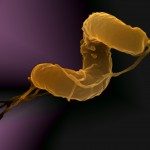Lien vers Pubmed [PMID] – 35812397
Lien DOI – 10.3389/fimmu.2022.911778
Front Immunol 2022 ; 13(): 911778
Leptospira interrogans is a bacterial species responsible for leptospirosis, a neglected worldwide zoonosis. Mice and rats are resistant and can become asymptomatic carriers, whereas humans and some other mammals may develop severe forms of leptospirosis. Uncommon among spirochetes, leptospires contain lipopolysaccharide (LPS) in their outer membrane. LPS is highly immunogenic and forms the basis for a large number of serovars. Vaccination with inactivated leptospires elicits a protective immunity, restricted to serovars with related LPS. This protection that lasts in mice, is not long lasting in humans and requires annual boosts. Leptospires are stealth pathogens that evade the complement system and some pattern recognition receptors from the Toll-like (TLR) and Nod-Like families, therefore limiting antibacterial defense. In macrophages, leptospires totally escape recognition by human TLR4, and escape the TRIF arm of the mouse TLR4 pathway. However, very little is known about the recognition and processing of leptospires by dendritic cells (DCs), although they are crucial cells linking innate and adaptive immunity. Here we tested the activation of primary DCs derived from human monocytes (MO-DCs) and mouse bone marrow (BM-DCs) 24h after stimulation with saprophytic or different pathogenic virulent or avirulent L. interrogans. We measured by flow cytometry the expression of DC-SIGN, a lectin involved in T-cell activation, co-stimulation molecules and MHC-II markers, and pro- and anti-inflammatory cytokines by ELISA. We found that exposure to leptospires, live or heat-killed, activated dendritic cells. However, pathogenic L. interrogans, especially from the Icterohaemorraghiae Verdun strain, triggered less marker upregulation and less cytokine production than the saprophytic Leptospira biflexa. In addition, we showed a better activation with avirulent leptospires, when compared to the virulent parental strains in murine BM-DCs. We did not observe this difference in human MO-DCs, suggesting a role for TLR4 in DC stimulation. Accordingly, using BM-DCs from transgenic deficient mice, we showed that virulent Icterohaemorraghiae and Manilae serovars dampened DC activation, at least partly, through the TLR4 and TRIF pathways. This work shows a novel bacterial immune evasion mechanism to limit DC activation and further illustrates the role of the leptospiral LPS as a virulence factor.


